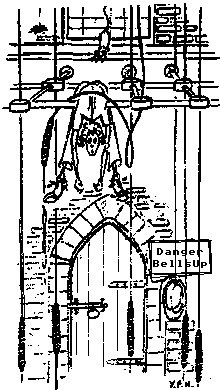 How do I tell whether a bell is up or not?
How do I tell whether a bell is up or not?The Tower Handbook
It is as safe as you make it. It cannot be denied that a mass of bell metal swinging under the influence of gravity can make a rope attached to it go wild - if you let it. If you have just learned to ring never experiment on your own. Always seek your tutor's guidance. If you are an experienced ringer, always ring correctly.
Anything in the wrong place can be a hazard. Anything sticking out (including dangling feet) can potentially get caught by a rope. Ringers should know to keep their feet on the floor when sitting out, but make sure non-ringing visitors do the same. Boxes standing on edge can easily fall over on someone's feet. Plain boxes always fall towards the side where the 'top' is (because it is heavier). Always put this side to the wall (but be aware that people stepping back against the box can then bang their shins on the edge, so don't place them just behind where people stand to ring).
If the church uses your ringing room as a store, be careful of candle stands, flower pot stands, wheelbarrows etc. It is best to remove them from the ringing room before you start. In a larger room make sure boxes, tables, chairs or coat racks do not get in the way of the moving ropes or the ringers. If you have a lively tower it might be worth trying to persuade the powers that be to use somewhere else as a store.
It depends on the layout of your ringing room. Generally, moving around outside the rope circle is all right, so long as you don't cause a distraction. Moving into the rope circle is generally forbidden (unless you are there already eg sitting at a table in the middle of the room). Walking close to the ringers, between them or in front of them, is distracting and could be hazardous.
In some towers, the answer will still be that you don't and you should wait until the bells are stood. But there will be cases where you need to cross the circle, but do not want to stop the ringing, and local custom may allow it. You can safely pass between ringers providing there is enough space, they know you are about to do it and you do it at backstroke when there is no loose rope around. To cross the circle, this probably means you need to wait a few seconds in the middle, like crossing a dual carriageway.
 How do I tell whether a bell is up or not?
How do I tell whether a bell is up or not?You can't tell from the look of the ropes. When a bell is up and set at handstroke its rope looks just as it would if it were down.
If you don't know, you must always assume that the bell could be up. You can find out, but to do so you must be prepared for it being up or down. So hold the tail end of the rope and grip the sally as if you were going to ring normally. Now pull gently as if you were lifting the bell towards the balance prior to pulling off. If the bell is down it will move slightly and then gently swing back. If it is up, it will not move until you have taken the weight of the bell and lifted it off the stay. When you relax, it will not swing but will just sit back against the stay.
If it is a light set bell and comes over the balance when you pull it you will have to ring it for a few blows and then stand it.
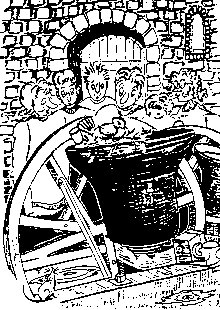 Should we always lower the bells after ringing?
Should we always lower the bells after ringing?In many parts of the country, ringers would not even ask the question, they would just do it. But in others there is a tradition of not lowering the bells regularly (apart from clock bells) or of only lowering them when there is a particular reason to do so, eg for maintenance. The first group sees raising and lowering the bells as a normal part of ringing, while the second sees it as a chore to be done only if needed.
In normal circumstances you should not leave the bells up as a permanent feature, in view of the potential risk if someone had to enter the tower while no ringers were present (eg a fire officer). There may be an insurance requirement to lower the bells.
Obviously in some cases the risk of leaving bells up is far greater than in others. With a ground floor ring open to the church and no means of completely securing the ropes out of reach [3] then bells should never be left up when you are not ringing. With a ringing room securely locked behind two doors up a flight of stairs, then leaving bells up for short periods between services may be acceptable. Leaving bells up overnight or longer is a very debatable practice. Church insurers now often stipulate that the bells should normally be lowered, especially during the working week. There have been some negotiations to cover exceptional cases. Check to find the conditions that apply to your church insurance.
Use warning signs. You need a big one in front of you when you come through the door and perhaps a small one attached to the cord for releasing the spider if you have one. Make sure the wording is explicit, eg 'Danger - Bells Up - Do not touch the ropes', or '... it is dangerous to touch the ropes'. Signs must be understandable by non-ringers, for example the rector or a fire inspector either of whom could enter the ringing chamber when you are not there. Statements like 'bells are upset' will probably engender mirth rather than any sense of danger.
In many towers it is customary to tie a different sort of knot in the rope to signal whether the bell is down or up. This works quite well in towers where they do it, but unfortunately you cannot rely on it in a strange tower. Many bands (and individual ringers) do not do this.
Most people who tie the same knot when up and down use up knots, so if you see down knots the bells probably are down, but up knots do not tell you much on their own. In fact as you go from tower to tower, you will see at least two sorts of down-knot and several variants of up-knot.
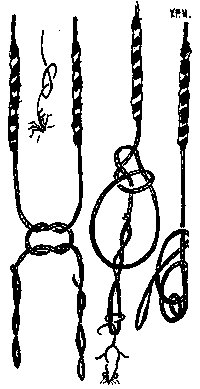 In many towers it is customary to tie a different sort of knot in the rope to signal whether the bell is down or up. This works quite well in towers where they do it, but unfortunately you cannot rely on it in a strange tower. Many bands (and individual ringers) do not do this.
In many towers it is customary to tie a different sort of knot in the rope to signal whether the bell is down or up. This works quite well in towers where they do it, but unfortunately you cannot rely on it in a strange tower. Many bands (and individual ringers) do not do this.
Most people who tie the same knot when up and down use up knots, so if you see down knots the bells probably are down, but up knots do not tell you much on their own. In fact as you go from tower to tower, you will see at least two sorts of down-knot and several variants of up-knot.
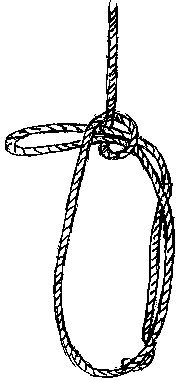 Up knot |
 Up knot (with doubled end) |
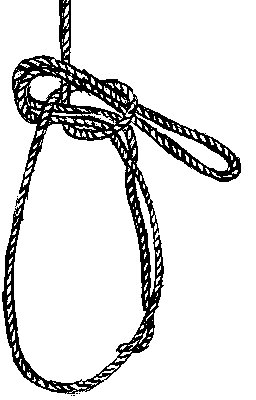 Down knot (pull end through up knot) |
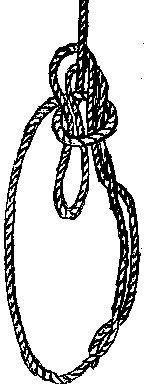 Down knot (bowline |
The essential feature of an up-knot is that it will come undone easily. Both those shown should fall apart if you fell and caught the loop. The one with the doubled end is least likely to lock up and also has the advantage that if you were to grab the end as the bell came off, the knot would untie itself. It is the safest knot.
Standing the bells at backstroke makes it clear to a ringer that they are up, and also makes it harder to catch one accidentally. But many people find it more difficult to stand the bells reliably at backstoke and some people can't reach to pull them off.
If you normally leave the bells down between ringing, then setting them at backstroke is an effective way of making sure that on the rare occasions when they are left up, no one (no ringer) will fail to spot that they are up.
Even the best handlers can be taken by surprise! It only needs the rope to slip wheel to break your natural rhythm. In the ensuing moments before regaining full control, even the best of us couldn't guarantee to prevent the rope ensnaring a loose tie and inflicting a nasty tug to the neck. In like vein, any other hanging appendages should be tucked in or removed, for example draw cords, belts with loose ends, strings of beads, neck scarves.
his depends on whether the bell keeps ringing or not. Whatever happens, don't panic. See section 5.4h if you want to know what happens when a rope slips wheel.
 The rope itself is unlikely to harm you as it falls down, but it could give you a fright if it fell on top of you. If you are ringing tidily this should not happen, but you will still find it very disconcerting if it has not happened before. In fact if you do realise what is happening, things can seem to go into slow motion. From feeling the rope go slack and realising it has broken, to having it in a heap at your feet, can seem a long wait, though it is only a few seconds.
The rope itself is unlikely to harm you as it falls down, but it could give you a fright if it fell on top of you. If you are ringing tidily this should not happen, but you will still find it very disconcerting if it has not happened before. In fact if you do realise what is happening, things can seem to go into slow motion. From feeling the rope go slack and realising it has broken, to having it in a heap at your feet, can seem a long wait, though it is only a few seconds.
Before you can replace the rope you have to get the bell down. Your options depend on where the rope has broken and on the layout of your tower.
We said above that you should not do this lightly or if you are not used to going among the bells. Remember if any mishap occurs you will be responsible. You should at least take these precautions.
In time the bell will come down by itself. You may be impatient, but trying to retard the bell until it is well down is very dangerous. Don't touch the wheel when it is moving fast. Even when it is nearly down, the intuitive way is dangerous. Don't touch the wheel when it is moving away from you. Even a small bell will pull you onto the wheel. If you must decelerate the bell, hold it only just before the end of the swing as it comes towards you. This will give you quite a knock, so be sure you are in balance and well braced. Wear leather gloves to protect your hands from splinters.
Not always! If you are not ringing, keep out of the way of those who are. If you are sitting down, keep both feet firmly on the floor. If you swing your feet, you may find them lassoed. This is more likely in a small ringing room.
For an individual, the ideal length is about four inches (100mm) of rope below the hands when your arms are comfortably at full reach at backstroke ringing rounds. With this length there is enough to let some rope out while hunting up, without fear of losing the rope end. And you won't have too much in hand if you need to take in rope to hunt down. Some people prefer a bit more than this.
For the band as a whole, you will have to make some compromises between the needs of your tallest and shortest ringers. If the ropes are adjusted for the taller ringers, the shorter ones must stand on boxes. If they are adjusted for the shorter ringers, then the taller ones must cope with excessive lengths of rope in their hands. Unfortunately no one has yet invented portable holes to allow tall ringers to stand below the ringing room floor!
Even if you keep your ropes on the long side, it is well worth shortening the ropes of bells used for teaching. Struggling with too much rope is an unnecessary handicap for a learner.
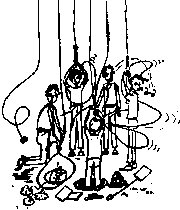 A long tail end is not just a nuisance. It could hit you in the eye or remove your glasses (if you wear them). When your hand stops moving at the bottom and top of the stroke, a loose tail end swings round like a whip. Look at a video recording of someone ringing with a long rope and you may be surprised just how far - upwards as well as downwards. It can deliver a vicious blow to your lower body as well as your head. In small ringing rooms people have even lassoed the coat pegs behind them.
A long tail end is not just a nuisance. It could hit you in the eye or remove your glasses (if you wear them). When your hand stops moving at the bottom and top of the stroke, a loose tail end swings round like a whip. Look at a video recording of someone ringing with a long rope and you may be surprised just how far - upwards as well as downwards. It can deliver a vicious blow to your lower body as well as your head. In small ringing rooms people have even lassoed the coat pegs behind them.
Maybe we need holes in the floor for tall ringers – see picture.
On balance, it is better to keep the ropes short enough for medium to tall ringers, with a selection of boxes for those smaller than average. Very tall ringers will have to handle more rope than ideal, but most of you will be able to ring with a comfortable length, either on the floor or standing on a box.
However well the ropes are adjusted in your own tower, sometimes you will find ropes too long elsewhere. Tall people do so much of the time! People have devised many different ways of coping with this. Here are some of them. The first two are widely recognised, but the others have all been used as well.
Warning. All these methods are for coping with, rather than preventing, long ropes. They involve attaching the loose rope to you in some way so make sure that if the rope were suddenly jerked away these attachments would not take your hand or fingers with the rope.
These answers are all directed at long tail ends, not at low sallies. To a considerable degree we can adapt to sallies of different height just by gripping a different part of the sally, but there comes a point where you run out of sally. If it is so low you find yourself gripping the single rope above it this can get uncomfortable, especially with a heavy bell. When the whole rope is too low (sally and tail end) some tall ringers kneel on the floor to ring. This is a more rigid posture (because you do not have the springiness in your knees) and the rope piles on the floor between strokes, but it can be preferable to fighting yards of spare rope. If you try this, make sure you kneel on something soft, like a kneeler, as stone floors can get very hard after five or ten minutes ringing.
 The pedestrian way.
The pedestrian way.
Hold the rope at a suitable place in one hand and wind the free part round in a figure of eight going in front of and behind the rope as appropriate. Finish by passing the end through the lower hole you have created.
The slick way.
Start with the rope tied in a standard 'up knot'. Instead of taking the end out to undo the knot, pull it completely through until the knot and the loop that was hanging below it all merge into a single knot. When you first do this it may not look like a figure of eight knot, but pull down the top loop and you will find it rearranges itself into one.
It depends on the type of stay you have. See section 5.5 & section 14.5 on stays. With the slider type, you should be able to feel the resistance of the stay against the slider before you set it. In some towers you can actually hear this action. But you should always let the bell go back from the balance onto the stay gently, as though you are expecting the stay to be missing.
If you are expecting a problem be extra cautious. Hold the bell over the balance and let it go slowly back. If the bell goes a long way, or you feel it getting heavier, try to pull it back and ring it down. If you cannot pull it back, there is no stay, so let go of the sally as described below.
If when you ease the bell back onto the stay, it feels 'spongy' and the bell goes a long way back, then it may be cracked and should be checked.
The bell loses the 'end stop' that normally stops it just beyond the balance. The bell keeps turning beyond the point where it would normally stop. As it goes further beyond the balance, it feels heavier so you cannot hold the rope which accelerates rapidly upwards. Attempting to stop it in this condition is dangerous. If you try to do so you will be lifted off the floor, possibly with serious injury.
Whatever the cause, if you don't feel the stay, and the rope continues to go up with increasing force, let go - do not try to stop it. You will only fail and injure yourself in the process. Most stays break at handstroke, so after you have let go of the sally, the rest of the rope will rapidly shoot up. Make sure your hands don't get caught up in it. On the first swing, the rope will probably go much higher than it normally does at backstroke, so be prepared to let go of the tail end as well. If you can hold the tail end, at least part of the time, try to stop it flying around, but hold it loosely in case it is wrenched from your hands again. Never try to get hold of the sally. After a while you may be able to hold the tail end again, and you can help the bell to ring itself down.
Don't feel guilty about breaking a stay if you are just learning. Many people do it, and your teacher should have provided enough supervision to prevent it happening. Many ringers have broken a stay at some time or other. Sometimes stays just break and it is no one's fault. Having said that though, if you are not under tuition, you should ask yourself whether your handling contributed to the problem.
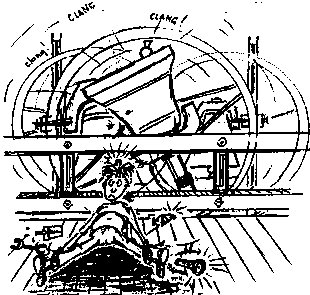 The simple answer is 'no', because it is dangerous.
The simple answer is 'no', because it is dangerous.
As noted above, the best policy is not to do it, but if you do, then do all you possibly can to minimise the risk to yourself and others. There is no completely safe approach, but these precautions are the least you should take:
Yes.
It depends whether it is set at handstroke or at backstroke. At handstroke the rope goes directly from the garter hole to the pulley and you can probably pull the bell off from below. It will feel much heavier, and the sally will be very low. The worse problem is at backstroke, which gives the feeling that the rope is 'jammed'. It is not really jammed, just wound round the headstock (see diagrams in section 5.4h). In this condition, whatever solution you adopt is dangerous. How dangerous depends on the layout of your bells and frame and on which way you do it. Read the precautions in section 3.1w before going near any bells that are up. The options are:
In this section, we have not just stuck to the standard advice like keeping your feet on the floor during ringing. We have tried to give helpful advice about the more difficult (and we hope rare) situations where the danger is much more real. It would be tempting for us to 'play safe' and just say 'never go near the bells when up'. But in extreme situations someone may have to break this rule (for example if a rope breaks and the bell sets).
If anyone does this, then it is better to minimise the risk by thinking about what could go wrong and taking sensible precautions. But there are still risks, and before you take them you must satisfy yourself that you have the necessary ability to handle them. If you are not sure, then it is better to play safe and seek the advice of someone more experienced who can help you. Remember, people have been killed by going near bells that are up.
Currently hosted on jaharrison.me.uk